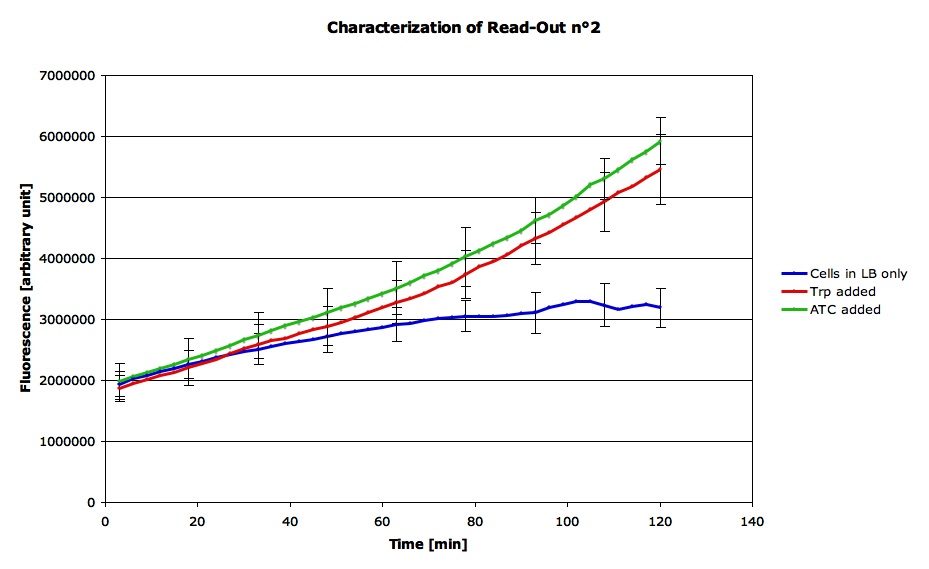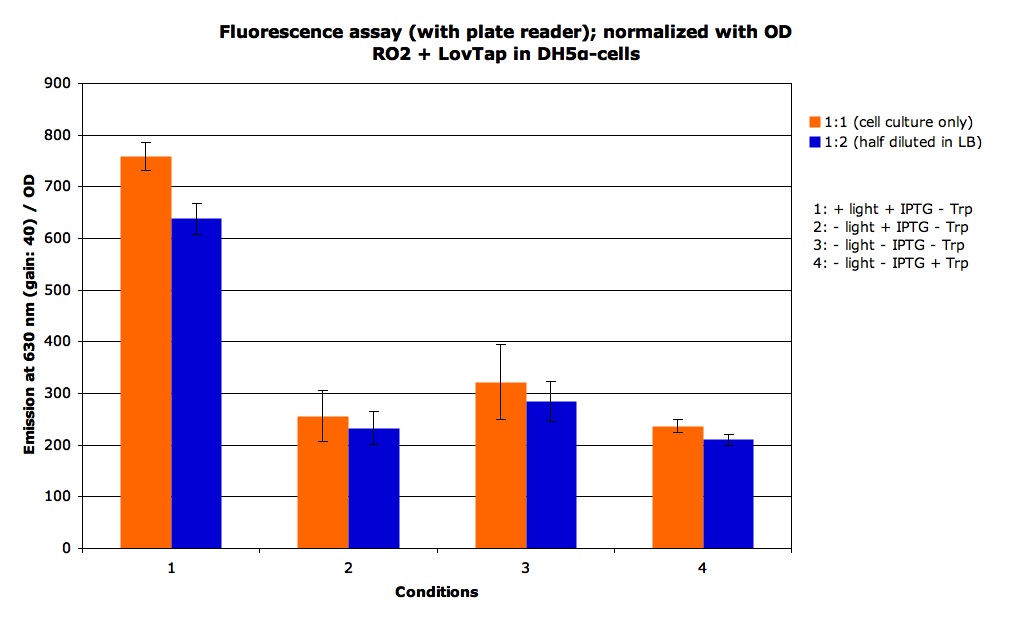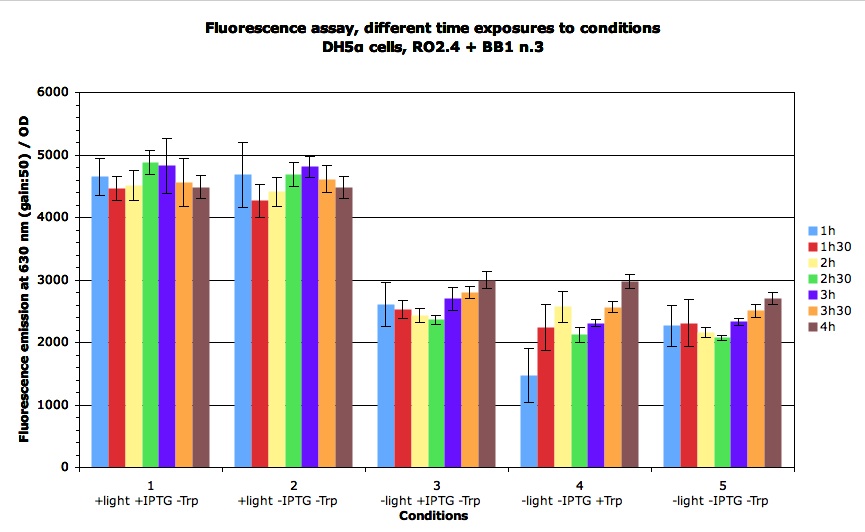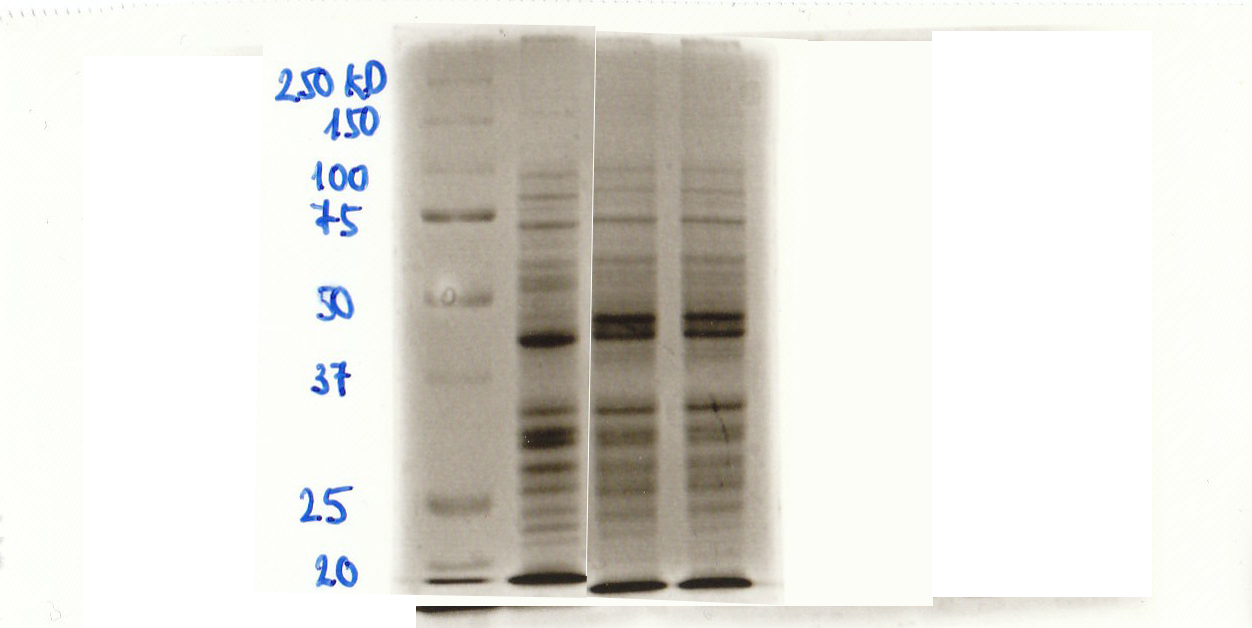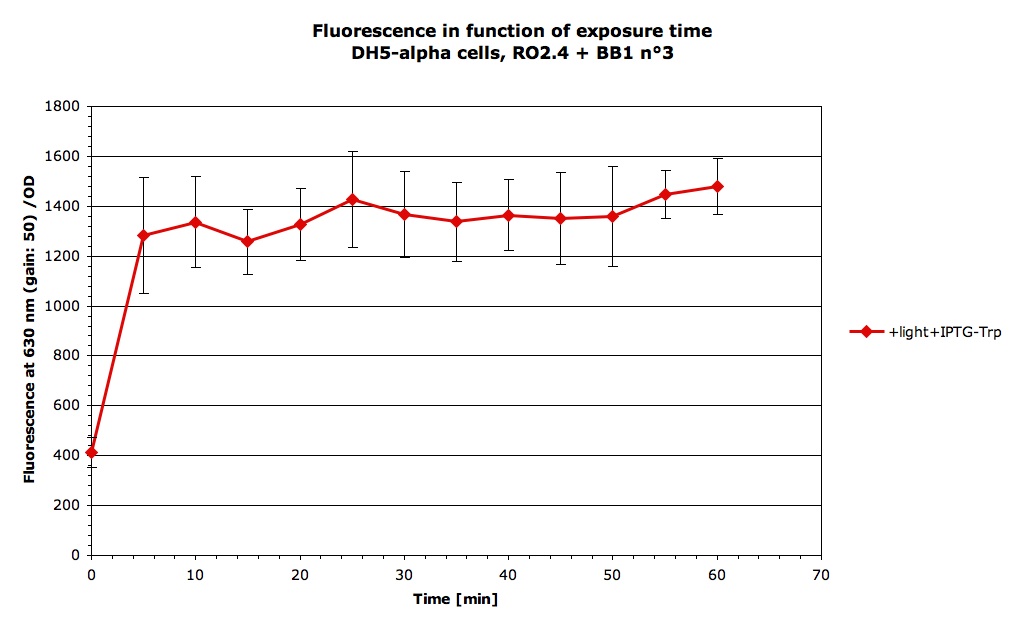Team:EPF-Lausanne/LOVTAP Results
From 2009.igem.org
(→Characterization of Read-Out n°2) |
(→Characterization of the entire system) |
||
| (5 intermediate revisions not shown) | |||
| Line 61: | Line 61: | ||
* Cells containing the read-out system were cultured overnight in M9 medium. | * Cells containing the read-out system were cultured overnight in M9 medium. | ||
| - | * The | + | * The following day, we re-inoculated 0.75 mL of cell culture into 25 mL of fresh medium in an Erlenmeyer flask. Incubated for 2 hours at 37°C. |
* Normalized the OD of all flasks to 0.06 by adding the appropriate amount of fresh medium. | * Normalized the OD of all flasks to 0.06 by adding the appropriate amount of fresh medium. | ||
| - | * Prepared the plate for the measurements with the qPCR machine, 50 ul per well. We used a 4.25 g/L tryptophan solution | + | * Prepared the plate for the measurements with the qPCR machine, 50 ul per well. We used a 4.25 g/L tryptophan solution. The conditions we tested were 1/2 Trp, 1 Trp and 3/2 Trp, 1/2 corresponding to 1 ul. |
* The plate was then loaded into the qPCR machine, which measured red fluorescence every 3 minutes, giving the graphs you can see below. | * The plate was then loaded into the qPCR machine, which measured red fluorescence every 3 minutes, giving the graphs you can see below. | ||
| Line 96: | Line 96: | ||
The read-out system n°2 is a signal inverter using a double-repressor system: there is a Trp promoter in front of the TetR gene, followed by the Tet promoter in front of the RFP gene. This means that it should react both to tryptophane and tetracycline, an allosteric blocker of TetR (for our experiments we used anhydrous tetracycline, ATC). | The read-out system n°2 is a signal inverter using a double-repressor system: there is a Trp promoter in front of the TetR gene, followed by the Tet promoter in front of the RFP gene. This means that it should react both to tryptophane and tetracycline, an allosteric blocker of TetR (for our experiments we used anhydrous tetracycline, ATC). | ||
| - | |||
| - | |||
| Line 135: | Line 133: | ||
| - | After having successfully | + | After having successfully characterized both of our read-out systems, we did further experiments in order to evaluate the function of our complete genetic circuit, which includes the LovTap biobrick (go to the [https://2009.igem.org/Team:EPF-Lausanne/Strategy Strategy page] for more information). For convenience, we chose to work with the read-out system n°2: indeed, since RFP doesn't contain a degradation tag, we assumed that the read-out n°1 would react more slowly, as it involved waiting for the RFP to be degraded before we could really see a response. In comparison, the read-out n°2 could give us a good indication of the kinetics of the response. |
The genetic circuit here being more complex, we conducted several different experiments which are described below. | The genetic circuit here being more complex, we conducted several different experiments which are described below. | ||
| Line 143: | Line 141: | ||
<font size="3">'''Experiment n°1: Single point measurement'''</font> | <font size="3">'''Experiment n°1: Single point measurement'''</font> | ||
| - | The purpose of this first experiment was to simply expose the cells to different conditions during a sufficient amount of time, in order to test the system and see whether we obtained a response. | + | The purpose of this first experiment was to simply expose the cells to different conditions during a sufficient amount of time, in order to test the system and see whether we obtained a light dependent response. |
<font size="3">'''Protocol'''</font> | <font size="3">'''Protocol'''</font> | ||
| Line 151: | Line 149: | ||
* Incubated cells in the different conditions for 2h30: for the light states, the "+light" samples were exposed to blue light only, while the "-light" samples were kept in the incubator in a dark box covered in aluminium foil (see [https://2009.igem.org/Team:EPF-Lausanne/Experimental_Setup Experimental Setup] for more details). | * Incubated cells in the different conditions for 2h30: for the light states, the "+light" samples were exposed to blue light only, while the "-light" samples were kept in the incubator in a dark box covered in aluminium foil (see [https://2009.igem.org/Team:EPF-Lausanne/Experimental_Setup Experimental Setup] for more details). | ||
* Loaded wells on a 96-well plate for microplate reader (200 ul per well), in normal daylight for the "+light" condition, and in the dark (or illuminated by anything else than blue light e.g. red light) for the "-light" condition. For each sample, quadruplicates were done. | * Loaded wells on a 96-well plate for microplate reader (200 ul per well), in normal daylight for the "+light" condition, and in the dark (or illuminated by anything else than blue light e.g. red light) for the "-light" condition. For each sample, quadruplicates were done. | ||
| - | * Used the microplate reader to measure simultaneously the OD (600 nm) and the emitted fluorescence (630 nm, Texas Red). Also, when | + | * Used the microplate reader to measure simultaneously the OD (600 nm) and the emitted fluorescence (630 nm, Texas Red). Also, when taking the measurements, we carried the plate in a dark box and set the plate reader so that cells were orbitally shaken at medium speed for 20 sec before the measurements were taken. |
| Line 171: | Line 169: | ||
<font size="3">'''Analysis & Conclusions'''</font> | <font size="3">'''Analysis & Conclusions'''</font> | ||
| - | Here we can clearly see that there is a | + | Here we can clearly see that there is a noticable difference in the levels of fluorescence between the samples in the light state and those not exposed to light. This shows that the LovTap protein is indeed expressed and active when the cells are exposed to blue light. On the other hand, there seems to be no response to Trp: this, however, can be explained by the fact that the experiment was done in LB medium, which already contains Trp. So it can be assumed that the Trp concentration was already "saturated" from the beginning of the experiment. |
| Line 191: | Line 189: | ||
<font size="3">'''Expected Results'''</font> | <font size="3">'''Expected Results'''</font> | ||
| - | + | As for the experiment n°1, we should see a higher level of fluorescence in the sample exposed to light and were LovTap is expressed by addition of IPTG, than in all other samples. For the "+light-IPTG" sample, we shouldn't see a very high level of fluorescence, since without IPTG, the LovTap protein shouldn't be produced. Concerning the different exposure times to conditions, there are 2 possibilities: | |
* After 1h of exposure, the maximal level of RFP expression has already been reached: in this case, all samples in the "+light+IPTG" state should show similar levels of fluorescence. | * After 1h of exposure, the maximal level of RFP expression has already been reached: in this case, all samples in the "+light+IPTG" state should show similar levels of fluorescence. | ||
* The maximal level of RFP expression has not yet been reached after 1h of exposure: here we should see a lower fluorescence for the first samples, with an increase over time until the maximal level is reached. | * The maximal level of RFP expression has not yet been reached after 1h of exposure: here we should see a lower fluorescence for the first samples, with an increase over time until the maximal level is reached. | ||
| Line 213: | Line 211: | ||
<font size="3">'''Experiment n°3: SDS-PAGE'''</font> | <font size="3">'''Experiment n°3: SDS-PAGE'''</font> | ||
| - | The purpose of this experiment was to compare levels of protein expression between cells cultured in LB with IPTG or without IPTG. Since the previous experiment suggested that the LacI promoter | + | The purpose of this experiment was to compare levels of protein expression between cells cultured in LB with IPTG or without IPTG. Since the previous experiment suggested that the LacI promoter may not be responsive , this will allow us to check whether LovTap is expressed at identical levels in both cases. If this is true, it would confirm that the LacI promoter doesn't work as expected, and is constitutively active. |
<font size="3">'''Protocol'''</font> | <font size="3">'''Protocol'''</font> | ||
| Line 276: | Line 274: | ||
<font size="3">'''Analysis & Conclusions'''</font> | <font size="3">'''Analysis & Conclusions'''</font> | ||
| - | By comparing the three patterns of protein expression, you can see that globally there is no difference between the "+IPTG" and the "-IPTG" samples, not even around 26 kD where the LovTap protein should be. From this we can | + | By comparing the three patterns of protein expression, you can see that globally there is no difference between the "+IPTG" and the "-IPTG" samples, not even around 26 kD where the LovTap protein should be. From this we can argue that the promoter is constitutively on, explaining why in experiment n°2 the "+light-IPTG" sample gave the same response as the "+light+IPTG" sample. Clearly a direct measurement of LOVTap concentration will be needed to conclusively state that our hypothesis is correct. |
Latest revision as of 20:47, 21 October 2009
Contents |




Characterization of Read-Out n°1
Our first read-out system consists of the Trp promoter followed by the RFP gene. In E. coli, the Trp promoter is situated in front of the Trp operon, which contains the genes necessary for the tryptophan biosynthetic pathway. In brief, genes placed after the Trp promoter should be repressed in the presence of tryptophan.
To characterize this biobrick, we cultured the cells in a medium without tryptophan: M9 medium to which we added all other amino acids and thiamine. You can find the protocol for the M9 medium here. The purpose of the experiment was to see the difference of RFP expression depending on whether we added tryptophane to the medium or not.
Protocol
- Cells containing the read-out system were cultured overnight in M9 medium.
- The following day, we re-inoculated 0.75 mL of cell culture into 25 mL of fresh medium in an Erlenmeyer flask. Incubated for 2 hours at 37°C.
- Normalized the OD of all flasks to 0.06 by adding the appropriate amount of fresh medium.
- Prepared the plate for the measurements with the qPCR machine, 50 ul per well. We used a 4.25 g/L tryptophan solution. The conditions we tested were 1/2 Trp, 1 Trp and 3/2 Trp, 1/2 corresponding to 1 ul.
- The plate was then loaded into the qPCR machine, which measured red fluorescence every 3 minutes, giving the graphs you can see below.
Please note that there was a time lag between when we started loading the wells on the plate and when the measurements began, so the induction might already have started.
Expected Results
In this experiment, we would expect to see a slight increase in fluorescence for the cells without tryptophan (simply due to cell growth), compared to a decrease in fluorescence for the samples in which we added tryptophan, since tryptophan would enhance the activity of the tryptophan repressor, which in turn would repress the RFP gene via the Trp promoter. Also to be noted, the RFP decay shouldn't be too abrupt, considering that the RFP protein used doesn't contain a degradation tag.
Graphs & Figures
Analysis & Conclusions
We can see that there is a decrease in RFP expression when Trp is added to the medium versus a stable expression for the -Trp condition, which corresponds to what we expected. From this we can therefore conclude that our first read-out system is functional, confirming that the sequence for the Trp promoter seems to be correct.
Characterization of Read-Out n°2
The read-out system n°2 is a signal inverter using a double-repressor system: there is a Trp promoter in front of the TetR gene, followed by the Tet promoter in front of the RFP gene. This means that it should react both to tryptophane and tetracycline, an allosteric blocker of TetR (for our experiments we used anhydrous tetracycline, ATC).
Protocol
- Cells were cultured overnight in LB medium at 37°C.
- Re-inoculated 1 mL of cell culture into 100 mL of fresh medium in Erlenmeyer flasks. Normalized the OD to 0.1 by adding fresh medium. Left to incubate at 37°C for about 2h30.
- Normalized the OD to 0.2 by adding fresh medium.
- In 2 mL Eppendorf tubes, gently mixed 1.8 mL of cell culture with 0.2 mL of Trp solution, ATC solution or cell culture (negative control). The solutions we used for Trp and ATC had respective concentrations of 8 mg/mL and 500 ng/mL (ATC solution in 50% EtOH).
- Loaded 30 ul into each well of the plate for the qPCR machine, with quadruplicates for each condition. The qPCR machine took a measurement of the fluorescence every 3 minutes: this was the data used to obtain the graph you can see further below.
Expected Results
For the negative control (cell culture only), we should see a basal level of RFP expression due to the leakage of the system; this level should remain more or less stable throughout the experiment. On the other hand, both the adding of Trp and ATC should result in an increase in fluorescence. For Trp, its presence in the medium should activate the expression of the Trp repressor, which binds to the Trp promoter, in turn repressing the TetR gene, and so preventing TetR from repressing the RFP gene. Similarly, ATC allosterically blocks TetR, and therefore also prevents it from repressing the RFP gene. In short, Trp and ATC should have a positive effect on RFP expression, thus leading to an increase in fluorescence.
Graphs & Figures
This graph shows the average curve for each condition (tryptophane added, ATC added, or nothing):
Analysis & Conclusions
In the graph, you clearly see that after a certain delay, an increase in fluorescence can be noted for the samples where Trp or ATC was added, while the fluorescence of the cells cultured in LB alone remains at a significantly lower level (note the error bars). This confirms that the read-out system reacts as expected, with an increase in fluorescence in response to both ATC and Trp. We can therefore assume that both the Trp promoter and the Tet promoter are functional and that we can use this part in order to characterize the functioning of the LovTap protein.
Characterization of the entire system
After having successfully characterized both of our read-out systems, we did further experiments in order to evaluate the function of our complete genetic circuit, which includes the LovTap biobrick (go to the Strategy page for more information). For convenience, we chose to work with the read-out system n°2: indeed, since RFP doesn't contain a degradation tag, we assumed that the read-out n°1 would react more slowly, as it involved waiting for the RFP to be degraded before we could really see a response. In comparison, the read-out n°2 could give us a good indication of the kinetics of the response.
The genetic circuit here being more complex, we conducted several different experiments which are described below.
Experiment n°1: Single point measurement
The purpose of this first experiment was to simply expose the cells to different conditions during a sufficient amount of time, in order to test the system and see whether we obtained a light dependent response.
Protocol
- Cells containing both the read-out n°2 and the LovTap biobrick plasmids were cultured overnight in 5 mL of LB at 37°C (cells were taken from a glycerol stock).
- For each condition to be tested, re-inoculated 1mL of cell culture broth into 7mL of fresh LB. Added all the "additives": for the Trp, diluted 25x a 4.25 g/L solution, for IPTG diluted 100x a 100mM solution.
- Incubated cells in the different conditions for 2h30: for the light states, the "+light" samples were exposed to blue light only, while the "-light" samples were kept in the incubator in a dark box covered in aluminium foil (see Experimental Setup for more details).
- Loaded wells on a 96-well plate for microplate reader (200 ul per well), in normal daylight for the "+light" condition, and in the dark (or illuminated by anything else than blue light e.g. red light) for the "-light" condition. For each sample, quadruplicates were done.
- Used the microplate reader to measure simultaneously the OD (600 nm) and the emitted fluorescence (630 nm, Texas Red). Also, when taking the measurements, we carried the plate in a dark box and set the plate reader so that cells were orbitally shaken at medium speed for 20 sec before the measurements were taken.
Expected Results
The LovTap protein should have the same effect on the read-out system as the Trp repressor would, except that LovTap is activated by exposure to blue light (versus presence of Trp in the medium for the Trp repressor). We should thus see a higher level of fluorescence in the sample exposed to light compared to a "basal" level for the samples kept in the dark.
Graphs & Figures
The graph below shows the level of fluorescence of samples having been incubated for 2h30 under different conditions. For each sample, the average and the standard deviation were computed. We also did dilutions by half with LB for each condition (on the plate), as a control.
Analysis & Conclusions
Here we can clearly see that there is a noticable difference in the levels of fluorescence between the samples in the light state and those not exposed to light. This shows that the LovTap protein is indeed expressed and active when the cells are exposed to blue light. On the other hand, there seems to be no response to Trp: this, however, can be explained by the fact that the experiment was done in LB medium, which already contains Trp. So it can be assumed that the Trp concentration was already "saturated" from the beginning of the experiment.
Experiment n°2: Multiple point measurements at 30 min intervals
In this experiment we tested the LacI promoter of the LovTap biobrick and wanted to evaluate how much exposure to the conditions was necessary in the light state in order to reach a maximal level of RFP expression.
Protocol
- Cells containing both the read-out n°2 and the LovTap biobrick plasmids were cultured overnight in 5 mL of LB at 37°C (cells were taken from a glycerol stock).
- For each condition to be tested, re-inoculated 1mL of cell culture broth into 7mL of fresh LB. Added all the "additives": for the Trp, diluted 25x a 4.25 g/L solution, for IPTG diluted 100x a 100mM solution.
- Incubated cells under the different conditions for 1h: for the light states, the "+light" samples were exposed to blue light only, while the "-light" samples were kept in the incubator in a dark box covered in aluminium foil (see Experimental Setup for more details).
- Every 30 min starting at 1h exposure: loaded wells on a 96-well plate for microplate reader (200 ul per well), in normal daylight for the "+light" condition, and in the dark (or illuminated by anything else than blue light e.g. red light) for the "-light" condition. For each sample, quadruplicates were done. Tubes were immediately placed back into the incubator after the samples for the plate were taken.
- Used the microplate reader to measure simultaneously the OD (600 nm) and the emitted fluorescence (630 nm, Texas Red). Also, when going to take the measurements, carried the plate in a dark box. Set the plate reader so that cells were orbitally shaken at medium speed for 20 sec before the measurements were taken.
Expected Results
As for the experiment n°1, we should see a higher level of fluorescence in the sample exposed to light and were LovTap is expressed by addition of IPTG, than in all other samples. For the "+light-IPTG" sample, we shouldn't see a very high level of fluorescence, since without IPTG, the LovTap protein shouldn't be produced. Concerning the different exposure times to conditions, there are 2 possibilities:
- After 1h of exposure, the maximal level of RFP expression has already been reached: in this case, all samples in the "+light+IPTG" state should show similar levels of fluorescence.
- The maximal level of RFP expression has not yet been reached after 1h of exposure: here we should see a lower fluorescence for the first samples, with an increase over time until the maximal level is reached.
Graphs & Figures
The graph below shows the level of fluorescence of samples having been incubated for 1h, 1h30, 2h, ..., 4h under different conditions. For each sample, the average and the standard deviation were computed.
Analysis & Conclusions
From this figure it is easily noticeable that the maximal level of RFP expression has already been reached after 1h of exposure to conditions, so the system is induced rather fast. Further experiments with much shorter time intervals between measurements and during the first hour of exposure have therefore been conducted to evaluate the kinetics of the response. However, the "+light-IPTG" sample shows the same level of fluorescence as the "+light+IPTG" sample: the logical explanation for this would be that the inducible promoter LacI in the LovTap biobrick is non-functional, and that as a consequence the LovTap protein is constantly produced in the cells. In order to verifiy this hypothesis, we decided to do an SDS-PAGE to compare levels of protein expression (see below, experiment n°3).
Experiment n°3: SDS-PAGE
The purpose of this experiment was to compare levels of protein expression between cells cultured in LB with IPTG or without IPTG. Since the previous experiment suggested that the LacI promoter may not be responsive , this will allow us to check whether LovTap is expressed at identical levels in both cases. If this is true, it would confirm that the LacI promoter doesn't work as expected, and is constitutively active.
Protocol
Lysis Buffer (2x) : for 100 ml
- 4g of SDS
- 20ml of glycerol
- 2ml of 2-Mercaptoethanol
- 70ml of stacking buffer (0.5 M Tris-HCl, pH=6.8)
- 100mg of Bromophenol blue
- 8ml of dd water
Make an overnight culture of the cell containing your protein of interest
1. Pellet the bacteria from the overnight culture @ 4000 rpm for 30 min. Do the centrifugation @ 4ºC
2. Discard the supernatant
3. Re-suspend the bacteria in 1 ml of dd water. Centrifiguate for 30 min/4000 rpm @ 4ºC
4. Discard the supernatant
5. Add approximately 1 equivalent of Lysis buffer to your cell pellet
6. Heat the solution for 10 min @ 95ºC
7. Add 1 equivalent of dd water
8. Heat for 10 min @ 95ºC
9. Centrifuge @ 11600 g for 10 min
-->Take the supernatant and apply the desired volume to a polyacrylamide gel (10 %)
Note : for coomassie blue staining, 5ul of the solution should be enough to have well-stained bands
- Stain your gel wiht a coomassie blue solution (in MeOH and AcOH)-->incubate with soft shaking @ RT for about 2h
- De-stain your gel using a 10% AcOH and 50% MeOH in water. The solution has to be changed every time it gets blue. You might need ot change the solution up to 20 times.
Note : for speeding the processes of staining and de-staining, you can put your gel+solution in the microwave for the couple of seconds. CAUTION to the MeOH vapors which are highly toxic. You should perform this process under a negative pressure fume hood.
Expected Results
The LacI promoter controls the expression of the LovTap protein, which weighs about 26 kD. Therefore, if the promoter works, at this position, we should see an additional band on the gel for the +IPTG sample, corresponding to this protein, compared to nothing or a faint band for the -IPTG sample. If the promoter is non-functional and constitutively on, we should see the exact same pattern of protein expression for the 2 samples tested.
Graphs & Figures
Photo of the gel: on the left is the negative control (cells with a plasmid for a ribosome binding site), in the middle is the sample of cells with IPTG and on the right those without IPTG (link to the page with the entire gel in the notebook here)
Analysis & Conclusions
By comparing the three patterns of protein expression, you can see that globally there is no difference between the "+IPTG" and the "-IPTG" samples, not even around 26 kD where the LovTap protein should be. From this we can argue that the promoter is constitutively on, explaining why in experiment n°2 the "+light-IPTG" sample gave the same response as the "+light+IPTG" sample. Clearly a direct measurement of LOVTap concentration will be needed to conclusively state that our hypothesis is correct.
Experiment n°4: Multiple point measurements at 5 min intervals during the first hour of exposure
The purpose of this experiment was to try to evaluate how much time of exposure to the conditions was necessary to induce our system.
Protocol
- Cells containing both the read-out n°2 and the LovTap biobrick plasmids were cultured overnight in 5 mL of LB at 37°C (cells were taken from a glycerol stock).
- Prepared individual Erlenmeyer flasks for every different time exposures. Re-inoculated 1mL of cell culture broth into 7mL of fresh LB. Added the IPTG, diluted 100x (of a 100mM solution).
- Incubated cells in the different conditions: for the light states, the "+light" samples were exposed to blue light only, while the "-light" samples were kept in the incubator in a dark box covered in aluminium foil (see Experimental Setup for more details). So that there wouldn't be too many interferences, the flasks were put into the incubator sequentially (every 5 min a flask was put inside), and after 1 hour all flasks were taken out at the same time.
- Loaded wells on a 96-well plate for microplate reader (200 ul per well), in normal daylight. For each sample, quadruplicates were done.
- Used the microplate reader to measure simultaneously the OD (600 nm) and the emitted fluorescence (630 nm, Texas Red). Also, when going to take the measurements, carried the plate in a dark box. Set the plate reader so that cells were orbitally shaken at medium speed for 20 sec before the measurements were taken.
Note: Between the moment when the flasks were taken out of the incubator and when the measurement was taken, there was a delay of about 10 min, during which protein expression can have started taking place (especially for the samples only briefly exposed to light).
Expected Results
We should see an increase of the level of fluorescence over time, illustrating the fact that the first samples have been less exposed to light and therefore the system has not yet been completely induced, and the maximal level of RFP expression hasn't been reached yet. On the other hand, if 5 min are enough to completely induce the system, all samples should have the same maximal level of fluorescence.
Graphs & Figures
In this graph, you can see the fluorescence levels for the samples at different time points. Each point on the graph is the average of the 4 values we had for each sample, the error barrs come from the standard deviation. The 0 min value corresponds to a sample that wasn't illuminated at all.
Analysis & Conclusions
We can see that all samples except the one that wasn't exposed to light show the same high level of fluorescence. From this experiment, we can conclude that only a very brief time of exposure to light is necessary in order to completely induce the system.
.
 "
"


